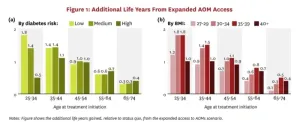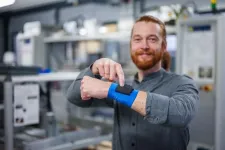(Press-News.org) Leveraging the power of AI and machine learning technologies, researchers at Weill Cornell Medicine developed a more effective model for predicting how patients with muscle-invasive bladder cancer will respond to chemotherapy. The model harnesses whole-slide tumor imaging data and gene expression analyses in a way that outperforms previous models using a single data type.
The study, published March 22 in npj Digital Medicine, identifies key genes and tumor characteristics that may determine treatment success. The ability to accurately anticipate how an individual will react to the standard-of-care therapy for this malignant cancer may help doctors personalize treatment and could potentially save those who respond well from undergoing bladder removal.
“This work represents the spirit of precision medicine,” said Dr. Fei Wang, professor of population health sciences at Weill Cornell Medicine and founding director of the Institute of Artificial Intelligence for Digital Health, who co-leads the study.
“We want to identify the right treatment for the right patient at the right time,” added co-lead Dr. Bishoy Morris Faltas, the Gellert Family–John P. Leonard MD Research Scholar in Hematology and Medical Oncology and an associate professor of medicine and of cell and developmental biology at Weill Cornell Medicine, and an oncologist at NewYork-Presbyterian/Weill Cornell Medical Center.
Dr. Zilong Bai, research associate in population health sciences, and Dr. Mohamed Osman, postdoctoral associate in medicine, at Weill Cornell Medicine, collaboratively spearheaded this work.
Better Model, Better Predictions
To build a better predictive model, the two lead researchers teamed up. While Dr. Wang’s lab focuses on data mining and cutting-edge machine learning analyses, Dr. Faltas is a physician-scientist with expertise in bladder cancer biology.
They turned to data from the SWOG Cancer Research Network that designs and conducts multi-center clinical trials for adult cancers. Specifically, the researchers integrated data from images of prepared tumor samples with gene expression profiles, which provide a snapshot of the genes that are "turned on" or "off.”
“Since expression patterns alone were not sufficient to predict patients’ responses in previous studies, we decided to pull in more information for our model,” said Dr. Faltas, who is also the chief research officer at the Englander Institute for Precision Medicine and a member of the Sandra and Edward Meyer Cancer Center at Weill Cornell Medicine.
To analyze the images, the researchers used specialized AI methods called graph neural networks, which capture how cancer cells, immune cells and fibroblasts are organized and interact within the tumor. They also incorporated automated image analysis to identify these different cell types at the tumor site.
Combining the image-based inputs with the gene expression data to train and test their AI-driven, deep-learning model, resulted in better clinical response predictions than models that used gene expression or imaging alone.
“On a scale of 0 to 1, where 1 is perfect and 0 means nothing is correct, our multimodal model gets close to 0.8, whereas unimodal models relying on only one source of data can achieve approximately 0.6,” said Dr. Wang. “That’s already exciting, but we plan to hone the model for further improvements.”
The Search for Biomarkers
As the researchers look for biomarkers such as genes that are predictive of clinical outcomes, they are finding clues that make sense. “I could see some of the genes I know are biologically relevant, not just random genes,” Dr. Faltas said. “That was reassuring and a sign that we were onto something important.”
The researchers plan to feed more types of data into the model such as mutational analyses of tumor DNA that can be picked up in blood or urine, or spatial analyses that would allow more precise identification of exactly what types of cells are present in the bladder. “That’s one of the key findings of our study—that the data synergize to improve prediction,” Dr. Faltas said.
The model also suggested some new hypotheses that Dr. Faltas and Dr. Wang are planning to test further. For example, the ratio of tumor cells to normal tissue cells, such as fibroblasts, impacts the response to chemotherapy predictions. “Perhaps an abundance of fibroblasts can shield tumor cells from chemotherapeutic drugs or support cancer cell growth. I would like to delve further into that biology,” he added.
In the meantime, Drs. Wang and Faltas will work on validating their findings in other clinical trial cohorts—and are open to extending their collaboration to determine whether their model can predict therapeutic response in a broader population of patients.
“The dream is that patients would walk into my office, and I could integrate all of their data into the AI framework and give them a score that predicts how they would respond to a particular therapy,” Dr. Faltas said. “It’s going to happen. But physicians like me will have to learn how to interpret these AI predictions and know that I can trust them—and to be able to explain them to my patients in a way they can also trust.”
END
AI meets oncology: New model personalizes bladder cancer treatment
2025-03-28
ELSE PRESS RELEASES FROM THIS DATE:
New approach could treat anthrax beyond the “point of no return”
2025-03-28
Anthrax, an infectious disease caused by the bacterium Bacillus anthracis, is often treatable in its early stages. But once the disease has progressed beyond the “point of no return” after just a few days, patients are almost certainly doomed.
In a new Nature Microbiology study, University of Pittsburgh researchers show that a cocktail of growth factors reversed would-be lethal cell damage in mice with anthrax, suggesting that this approach could be adapted for use in patients beyond the brink.
“While only a few people die from anthrax in the United States each year, there is always the concern ...
Those constantly distracted by their phone will just find other ways to procrastinate if it isn’t nearby
2025-03-28
If you just put away your phone to read this, chances are you’re not alone. Our phones are an endless source of distraction, and we interact with them every four to six minutes. This is often driven by habit as well as notifications, leading to a disrupted flow of activity while we’re trying to be productive.
A new study published in Frontiers in Computer Science investigated if placing smartphones just out of our reach while we’re at work influenced device use for activities not related ...
Ottoman Empire’s religious ‘tolerance’ another form of control
2025-03-28
Population surveillance. The carrying of identification while traveling. Add to that the public presence of diverse religions and it sounds like 2025, but this was life in the Ottoman Empire 200 years ago. Yet this seeming tolerance of non-Muslim faiths was in fact tied to the first two aspects, according to research by Osaka Metropolitan University Associate Professor Masayuki Ueno.
The Ottoman Empire lasted from around 1300 until 1922, and at various points in its history ruled present-day Turkey, Egypt, Greece, Hungary, and beyond. In the wake of the 1821 Greek revolt, the Ottoman Empire instituted ...
Smartphone bans alone fail to equip children for healthy use of technology
2025-03-27
Banning smartphone and social media access alone fails to equip children for healthy use of technology, argues a group of international experts in The BMJ today.
They say the focus should shift to a rights based approach, underpinned by age appropriate design and education, that protects children from harm while developing skills to help them participate in a digital society.
Bans on smartphone and social media access have been advocated in many countries to protect children from harm despite ...
Discovery of novel small compounds that delay flowering in plants
2025-03-27
Ikoma, Japan—In an era where climate change threatens food security, scientists worldwide are searching for reliable ways to improve crop production. Extreme weather and shifting seasonal patterns can disrupt traditional agricultural cycles, making technologies that regulate the timing of plant growth invaluable for farmers worldwide.
Plant growth and development are dependent on many factors such as the environment, photoperiod, and genetics. Flowering is an important event in a plant’s life ...
Expanding access to anti-obesity medications delivers 13% return on investment for society
2025-03-27
A new USC Schaeffer Center white paper finds expanded access to anti-obesity medications would lead to significant increases in life expectancy and disease-free years while generating a substantial societal return on investment, even after accounting for treatment costs.
More than 4 in 10 U.S. adults have obesity, which is linked to increased risk of over 200 diseases — including heart disease, diabetes, cancer and dementia — and costs society $260 billion annually to treat. Highly effective new anti-obesity medications can be a powerful tool against chronic disease, but fewer than one-third of health insurers cover them amid concerns about upfront ...
Genetic defense breakthrough: plants repurpose stomatal genes to fend off herbivores
2025-03-27
Ikoma, Japan—Throughout evolution, plants have continuously adapted to survive in changing environments. Apart from complex structural changes, plants have also developed various defense strategies against herbivores, including tougher protective layers, thorns, and chemical deterrents. Delving deeper into the evolution of defense mechanisms, a research team led by Assistant Professor Makoto Shirakawa from Nara Institute of Science and Technology (NAIST), identified a surprising genetic adaptation in the Brassicales plant order. In these cruciferous ...
David B. Allison, Ph.D., Daniel W. Belsky, Ph.D., and Arlan Richardson, Ph.D., to receive 2025 Scientific Awards of Distinction from the American Federation for Aging Research
2025-03-27
New York, NY — The American Federation for Aging Research (AFAR), is pleased to announce the 2025 recipients of three of its annual Scientific Awards of Distinction: David B. Allison, PhD, will receive the Irving S. Wright Award of Distinction; Daniel W. Belsky, PhD, will receive the Vincent Cristofalo Rising Star Award in Aging Research; and Arlan Richardson, PhD, will receive the George M. Martin Lifetime Achievement in Mentoring Award.
The Irving S. Wright Award of Distinction is named in honor of AFAR’s founder and recognizes exceptional contributions to basic ...
Pregnant women advised to avoid mentholated e-cigarettes
2025-03-27
RIVERSIDE, Calif. -- Vaping during pregnancy is becoming more common, but its impact on early human development is not well understood. A new study by scientists at the University of California, Riverside, now reports that the flavor chemical menthol used in electronic cigarettes could pose risks to a developing baby.
The study, published in STEM CELLS Translational Medicine, used human embryonic stem cells, or hESCs, to characterize early stages of embryonic development and examined how low concentrations of menthol affect important cellular processes.
The ...
Smart textiles and surfaces – How lightweight elastomer films are bringing tech to life
2025-03-27
Clothes that can mimic the feeling of being touched, touch displays that provide haptic feedback to users, or even ultralight loudspeakers. These are just some of the devices made possible using thin silicone films that can be precisely controlled so that they vibrate, flex, press or pull exactly as desired. And all done simply by applying an electrical voltage. The research teams at the Center for Mechatronics and Automation Technology in Saarbrücken (ZeMA) headed by Professors Stefan Seelecke and Paul Motzki (Saarland University) and John Heppe (htw saar – University of Applied Sciences ...





